How lucky we are to have our own personal guide to steer us around the lovely city of Belfast. Here we are on another beautiful day, to learn more about the city, it's struggles of the past and it's rejuvenation.
Today though, we'll be focusing mostly on the Political side of Belfast's history, with some other interesting bits in between.
As we head for the city, we past another of Belfast's 'hard to miss'
Steel sculptures, this one known as 'The Ring of Thanksgiving". The
poignancy that this sculpture should be the first of our sights to see today as
we begin our tour of Belfast, isn't lost on me.
 |
| The Ring of Thanksgiving Statue, Queen's Bridge, Belfast |
The Ring of Thanksgiving, featuring a woman carrying, well..... a ring of course, is situated at Queen's Bridge & is symbolic of the renaissance of the city. It is known locally by several titles including, 'the angel of thanksgiving', 'the beacon of hope' & more comically as 'Nuala with the Hula', 'The Loop with the Hoop' & my personal favourite, 'The Thing with the Ring'.
I just love this scurrilous penchant the Irish have for renaming their public monuments! I do wonder however, what the sculptors of these magnificient creations must think about the comical use of rhyming slang to rename their masterpieces? I do hope they have a sense of humour.... surely they're not Irish if they don't. The sculptor of this statue though, is a Scotsman!
 |
| St George's Market, Belfast |
We pass the St George's Market built between 1890 and 1896, it holds a weekly Friday Variety Market as well as the City Food and Craft Market on Saturdays. Today though, the gates were open, but the stalls were empty.
 |
| Telephone House, Cromac St, Belfast |
The next building of interest we pass, mainly because it was the former place of work for my cousin's husband, is Telephone House on Cromac Street, an ugly concrete box of a building with bricked up windows on the ground floor. It houses one of BT's biggest exchanges in Northern Ireland, and the BBC and the main mobile companies also have major trunking through it. It was a high security building especially during the 'Troubles', when armed military personnel were stationed in it for a time. These buildings were designed to be as secure as fort knox & bomb proof.
Our first stop of the day was the Ulster Museum, situated in the Botanic Gardens next to Queen's University. Here I wanted to see the museums Exhibition on 'The Troubles', the period of Northern Ireland's history from 1968. Much of this period, because it is so recent & because it was so traumatic, is still painfully - often bitterly - remembered by those who were injured, their families & the families of those who died. In all, there were some 3,700 deaths, around 50,000 explosions & innumerable sectarian incidents.
There are graphic photographs portraying 'the Troubles' including the Civil Rights confrontations of 1968 in Londonderry [also known as Derry] which brought Northern Ireland's problems to the attention of the World - Policing, & the casualty rate of the Royal Ulster Constabulary, where 1 in 16 serving members was killed or injured - The 'Bloody Sunday' march of November 1972, which resulted in the deaths of 14 civilians in Derry, all shot by British soldiers - Prisons & the dramatic rise of prisoners as violence & paramilitary activity escalated, resulting in the need for more prisons to be built. This included the infamous Long Kesh Prison known as 'The Maze' or 'H-Block' where many of the political prisoners were held.
 |
| Photo of H-Blocks at 'The Maze', Long Kesh Prison - Ulster Museum, Belfast |
Other themes portrayed in the exhibition included the Internments without trial, Paramilitary organisations, Hunger Strikes & the Political Developments throughout this period. It was a sobering experience, but armed me with more knowledge of the Trouble's than I'd ever had previously. However, as I left the museum, I felt sure that this was just the beginning of my education about Northern Ireland's troubled past.
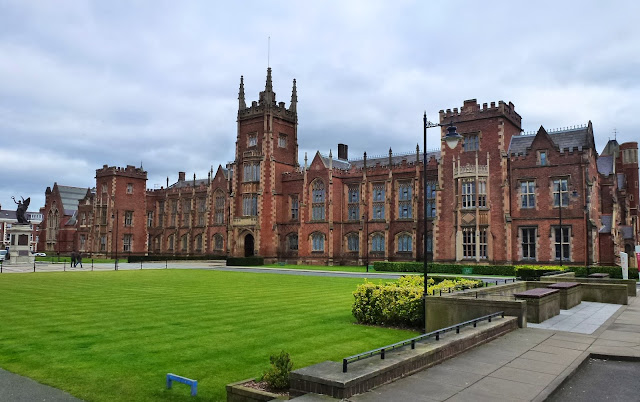 |
| Queen's University, Belfast |
Right next to the Ulster Museum is the stunning building of Belfast's Queen's University.
Founded by Queen Victoria & opened in 1849, Queen's University was designed to be a non-denominational alternative to Trinity College in Dublin which was controlled by the Anglican Church. It was also the first University in the north of Ireland.
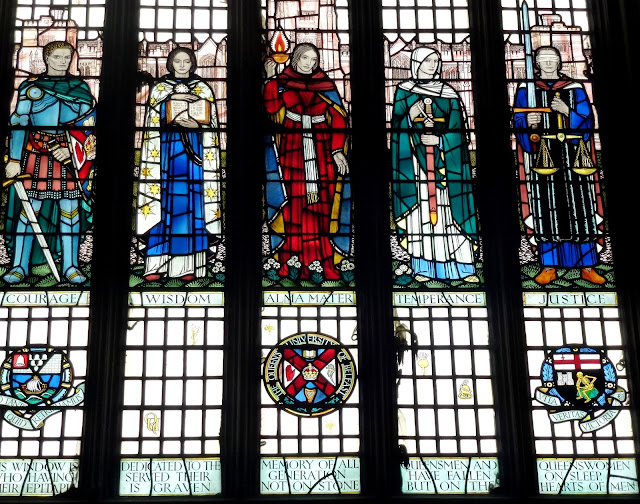 |
| Stained Glass window inside Queens University, Belfast |
 |
| The Great Hall, Queen's University, Belfast |
As both of my cousin's daughters attended Queen's, she confidently walked us around the campus, something we probably would not have done had she not been with us to show us around. And so it was she was able to lead us straight into the Great Hall, a beautiful room with a high ceiling & panelled walls lined with impressive portrait paintings from the University's Art Collection.
 |
| Art Collection, The Great Hall, Queens University, Belfast |
 |
| Queens University, Belfast |
 |
| City Hall, Belfast |
In the heart of Belfast is the City Hall, Belfast's City Council's civic building. Once a target for IRA bombers, this beautiful neo-classical building dominates Belfast’s old city center.
Did you know that green domes atop many of this style of building are made of copper? They start out looking a brown colour and over time they turn green because of a chemical process called oxidisation. The dome on Belfast City Hall is green for that reason.
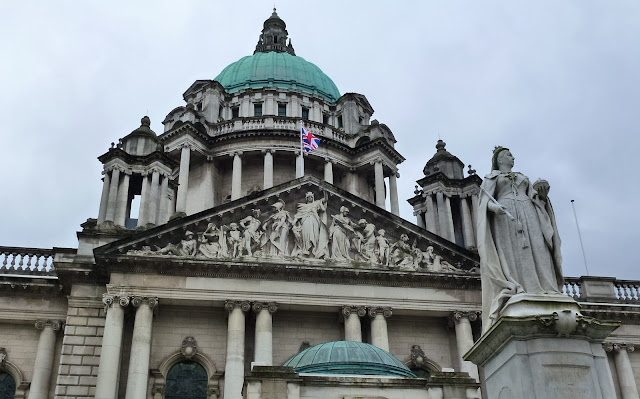 |
| City Hall, Belfast |
 |
| The Domed ceiling of the City Hall, Belfast |
 |
| Part of a stained glass window celebrating the Dockers & Carters Strike of 1907, City Hall, Belfast |
One such work of art was the stained glass window celebrating the Dockers & Carters Strike of 1907. This strike brought together poorly paid dock workers, both Catholic & Protestant to strike against poor working conditions & low pay.
The words at the bottom of the window which caught my eye [the only portion of the window I photographed, sorry], are apparently taken from a poster seen on the Falls Rd at the time of the strike. Some believe the words to be poignant in more current times, with steps, now well forged to create a new, prosperous & peaceful Belfast, united in a shared pride in their city.
 |
| City Hall, Belfast |
 |
| Belfast City, Northern Ireland |
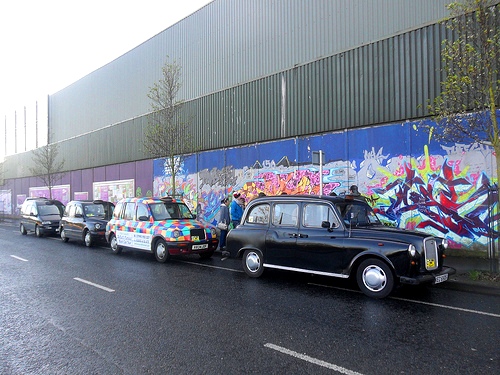 |
| Paddy Campbell's Famous Black Cab Tours at the Peace Wall, Belfast, Northern Ireland Image Credit Paddy Campbell's Black Cab Tours |
My Taxi Cab Tour of choice was Paddy Campbell's Famous Black Cab Tours. I was keen to get Paddy himself, but when I rang him he sounded poorly & explained he was home on the couch with 'man-flu'. Though I was disappointed not to have the Famous Paddy as our guide, his replacement, a Scotsman by the name of John was very good & picked us up promptly outside the gates of the City Hall. John had lived in Belfast for many many years so had plenty of experience of the Troubles & the city.
 |
| Shankill Road Murals, Belfast |
The Shankill Road area was our first stop, where we were able to get out & walk around the streets & take photos of the murals.
 |
| Loyalist Paramilitary Mural, Shankill, Belfast |
Perhaps one of the more menacing Murals in the Shankill Road area is this one representing the UDA - Ulster Defence Association. The most striking aspect of this mural is the balaclava clad gunman in the centre taking careful aim down the barrel of his rifle, pointing directly at you no matter what angle you looked at it from!
 |
| Loyalist Paramilitary Mural, Shankill Road, Belfast, Northern Ireland |
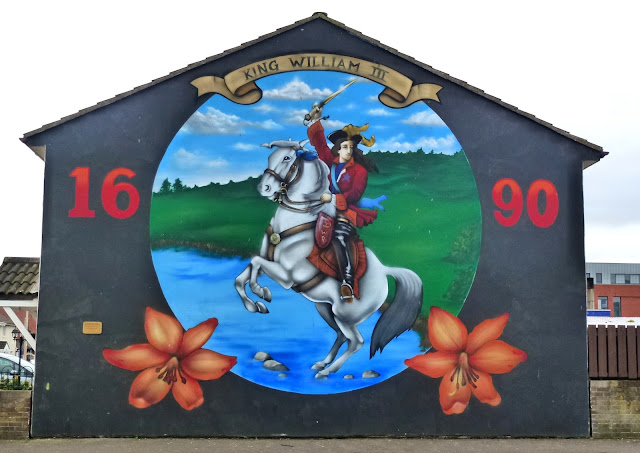 |
| King William III, Shankill Road, Belfast |
 |
| Freedom 2000 - The Maze [H Block] Prison, Shankill, Belfast |
 |
| Mythology figure of Cuchulainn, Shankill Rd Murals, West Belfast |
The mythological figure of Cuchulainn which had always been considered an 'Irish hero' was adopted by the Loyalist community as an Ulster hero with it's ties to Scotland. Myth has it that Cuchulainn defended his territory from the Irish aggressors of the South.
 |
| Lt. Col. Bucky McCullough, Shankill Rd Murals, Belfast |
A native of the Shankill Road area, McCullough was a Loyalist paramilitary member, gangster & racketeer. He was killed by the INLA [Republican Irish National Liberation Army] in 1981 while preparing to drive one of his daughters to school. A motorcycle drove up and the pillion passenger opened fire as McCullough was getting into his car. This mural is situated within meters of where he lived.
 |
| The Red Hand of Ulster Mural, Shankill, Belfast |
Regarded as one of the few cross-community symbols used in Northern Ireland due to it's origins as an early Gaelic Irish symbol, the Red Hand is often seen in both Republic / Nationalist & Loyalist / Unionist symbolism.
The best known 'yarn' about the origins of the Red Hand involves a Viking long boat party, coming ashore in Ulster. The leader promises the first man to touch the land, full possession of the territory. One of the party severs his hand with his sword & throws it ashore, thus claiming the land. It's not surprising to read I suppose, that some policy makers today are keen to see this symbol phased out due to its tarnished reputation associated with violence & land ownership over the years. However, this may be a tall ask considering the symbolism of the Red Hand is so intrinsically rooted in Ireland's past.
 |
| Mural in Loyalist area, Belfast |
The Crumlin Road Courthouse in north Belfast has been lying derelict for 15 years & after a series of fires several years ago, the building has been left exposed to
the elements. Its future is still uncertain.
We then drove from the predominately Loyalist area of Shankill Road into the predominately Nationalist area of the Falls Road.
 |
| Bobby Sands Mural, Falls Road, Belfast |
Long-time activist against the British in Northern Ireland, Bobby Sands was an Irish volunteer of the Provisional IRA. He lead the hunger strike campaign for political status for IRA prisoners & gained international recognition, after being elected an MP of the UK Parliament at Westminister while in H-Block at Long Kesh Prison [The Maze]. His death from starvation, resulted in a new surge of IRA recruitment & sparked riots in many parts of Northern Ireland & in the Republic.
We stop next at the ‘International Wall’ on Divis Street, painted with colorful Republican murals with images alluding to human rights struggles here & around the world.
 |
| Falls Curfew Mural, Divis St nr. Falls Rd, Belfast |
The Falls Curfew Mural depicts the search in July 1970, for paramilitary weapons in the Falls Road area which turned into rioting and gun fights after which, the British army imposed a curfew around the area during which 4 civilians were killed & 75 wounded. The curfew was broken on the Sunday morning, when 3,000 nationalist women marched through the area with food and groceries for the people residing there. Despite the soldiers trying to hold the crowd back, the women were eventually allowed to pass and the curfew was broken.
The Falls Curfew was notable for the beginning of worsening of relationships between the British Army and the Catholic working class.
When Margaret Thatcher refused to give IRA prisoners their Prisoner of War status in 1976, an array of protests took place. One of these was the 'blanket protest'. This began with the interment of Kieran Nugent, the first prisoner to be sentenced under the new regime refusing to wear prison clothes, choosing instead to wrap himself in a blanket. By 1980, there were over 300 Republican paramilitary prisoners refusing to wear clothes & saw the escalation of the protest into hunger strikes.
 |
| Bombay Street Rememberance Plaque, Belfast |
 |
| The Clonard Martyrs Memorial, Belfast |
The Clonard Martyrs Memorial Garden commemorates members of the IRA, ex-prisoners, political activists, and civilians from the Clonard area who lost their lives during the 'Troubles'.
 |
| Paddy Campbell's Cab Tours, At the Peace Wall, Belfast |
Peace Lines or Peace walls as they're referred to like this one in Cupar Way, Belfast, are a series of separation barriers, this one ranging in length from a few hundred yards to over three miles, the purpose of which, was to minimize sectarian violence between Protestants and Catholics. Some have gatesways, occasionally manned by police, allowing passage by day but are closed at night.
The Peace lines are high, higher than I'd imagined them. With the added barbed fencing on top, they are well over twenty-five feet, high enough to stop most missiles from being thrown over. Whole streets were in effect halved by this wall, coming to an abrupt end where the wall towers.
 |
| Gates in peace walls are locked at night separating Catholic areas from Protestant |
 |
A peace wall in Townsend Street looking from the Catholic side towards the Shankill Protestant area. This gate is closed at 5.30pm and opened at 7am.
|
 |
| Peace Wall, Cupar Way, Belfast |
In the end, all I could think of to write is 'Peace', my name & the date. In the end it is a record of my visit, to say 'I was here'. And in time it will be written over, like so many other messages on the wall. One day, it'll probably be washed down with paint, erased clean, perhaps to start again, but hopefully, oneday, it will all disappear for completely, when the wall comes down for good.
So rather than leaving a message, I leave a prayer... that one day there'll be a fully united community here, feeling at ease with one another & secure, living side by side.
This was the end of our Mural tour. I'd learnt alot more & while this was another sobering experience, I'd recommend it as a 'must see' tour for anyone visiting Belfast.
It was now time for a cuppa, so our cabby John, dropped us off right at the door of the historic Crown Bar. "A cuppa in The Crown Bar!" I hear you say.....
The first thing you notice about the Crown Bar are the eclectic array of mosiacs, on the outside as well as the inside of the building, including a mosiac of a Crown inlaid into the concrete at the entrance way to the Bar.
 |
| The Mosaic Entrance to the Crown Bar, Belfast |
 |
| The Crown Bar, Belfast |
 |
| Inside The Crown Bar, Belfast |
While The Crown Bar was always seen as a neutral pub during The Troubles, this was of little comfort in protecting it from the misfortune of being situated right across the street from the Europa Hotel, infamous for being the most bombed Hotel in Europe. Everytime the Europa was bombed, the Crown Bar sustained damaged too.
The Europa Hotel was picked out as a target by the IRA because it symbolized wealth & prestige. The exact number of bombings varies depending on who's telling the story, but is estimated to be around 27! And like the Crown Bar, the Hotel picked itself up after each bomb blast & carried on, undefeated, business as usual.
Right next door to the Europa Hotel is Belfast's beautiful Grand Opera House. Opened in 1895 as a theatre, it was converted into a Cinema around the early 50's but by 1972 during the height of 'The Troubles', the building was closed up. Looking certain to be demolished, it's future was assured when it was listed as being of historical & architectural importance. After a major restoration effort, it was reopened as a theatre in 1980.
In 1991 & again in 1993, the Opera House was badly damaged by bomb blasts but just as the Europa & the Crown had done, this Grand old lady picked herself up & carried on.
Our last stop on our 'political' tour was a visit to Stormont. Built in the 1920's as the seat of Parliament for Northern Ireland, it is now the Home of the restored Northern Ireland Assembly. This impressive building is situated in the vast grounds of Stormont Estate.
 |
| The Grand Opera House, Belfast |
Right next door to the Europa Hotel is Belfast's beautiful Grand Opera House. Opened in 1895 as a theatre, it was converted into a Cinema around the early 50's but by 1972 during the height of 'The Troubles', the building was closed up. Looking certain to be demolished, it's future was assured when it was listed as being of historical & architectural importance. After a major restoration effort, it was reopened as a theatre in 1980.
In 1991 & again in 1993, the Opera House was badly damaged by bomb blasts but just as the Europa & the Crown had done, this Grand old lady picked herself up & carried on.
Our last stop on our 'political' tour was a visit to Stormont. Built in the 1920's as the seat of Parliament for Northern Ireland, it is now the Home of the restored Northern Ireland Assembly. This impressive building is situated in the vast grounds of Stormont Estate.
One of the more interesting stories about Stormont is when, during WW2, in an effort to camouflage the building, it was painted with a removable paint then smeared with cow manure! However, after the war, the supposed removable paint took 7 years of restoration work to remove.
It's easily one of the most statuesque buildings in the city, situated within the pristine grounds of Stormont Estate. Prince of Wales Avenue up to the building stretches about a mile uphill, making for great views, a nice walk on a sunny day, or a run workout to the top and back for the aerobically minded.
 |
| Stormont Estate, Belfast, Northern Ireland |
 |
| Stormont, Belfast |
 |
| Stormont, Belfast |
Tomorrow is a new day & our Belfast tour will continue, this time with a focus on the renewal & transformation of this brave & beautiful city.













Very interesting, thank you!
ReplyDeleteLoved this. Made me feel homesick.
ReplyDeleteThank you for dropping by. Belfast is a great city & I'm looking forward to exploring it all over again in 6 weeks time.
Delete